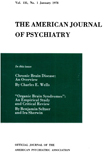MENTAL SYMPTOMS IN CASES OF TUMOR OF TEMPORAL LOBE
Abstract
In the series of 61 temporal lobe tumors there were mental symptoms in 50 cases. As initial symptoms there were mental manifestations in 37 cases before any neurological signs appeared. The symptoms were are follows: 1. fits (hallucinations, visual illusions, dreamy state, automatism, psychomotor equivalent, temporal epilepsy), 2. changes in personality, 3. disorders of mood, 4. schizoform psychosis, 5. parietal mental symptoms, 6. psycho-organic syndrome.
We do not assume a definite mental syndrome of tumor of temporal lobe. We would only emphasize, that the psychic syndromes are never manifestations only of damage of a circumscribed part of the brain, but always as a damage of the function of the brain as a whole. From the clinical symptoms and their connections with the local lesions, one can only conclude that certain neuron groups play greater part in some or in specific brain activities. On the basis of literary data, of our own material and observations with electric stimulations of the cortex by Penfield and co-workers, we assume, that some type of hallucinations, déjà vu experiences, dreamy states, automatism, psychomotor equivalence, temporal epilepsy can be—with great probability—significant of temporal lobe lesions. Paying more attention to these symptoms and making greater use of the results of other examinations we will be enabled to make an earlier and more accurate diagnosis to establish the temporal lobe tumor.
Access content
To read the fulltext, please use one of the options below to sign in or purchase access.- Personal login
- Institutional Login
- Sign in via OpenAthens
- Register for access
-
Please login/register if you wish to pair your device and check access availability.
Not a subscriber?
PsychiatryOnline subscription options offer access to the DSM-5 library, books, journals, CME, and patient resources. This all-in-one virtual library provides psychiatrists and mental health professionals with key resources for diagnosis, treatment, research, and professional development.
Need more help? PsychiatryOnline Customer Service may be reached by emailing [email protected] or by calling 800-368-5777 (in the U.S.) or 703-907-7322 (outside the U.S.).



